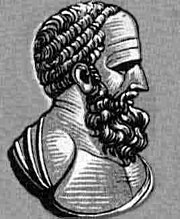|
|
| |
|
|
| |
|
|
|
|
| |
 |
| Hipparchus, credited
with compiling the first trigonometric table,
has been described as "the father of
trigonometry". |
Trigonometry
Trigonometry (from the Greek trigonon = three angles and
metron = measure) is a part of elementary mathematics
dealing with angles, triangles and trigonometric
functions such as sine (abbreviated sin), cosine
(abbreviated cos) and tangent (abbreviated tan). It has
some connection to geometry, although there is
disagreement on exactly what that connection is; for
some, trigonometry is just a section of geometry.
Overview and definitions
Trigonometry uses a large number of specific words to
describe parts of a triangle. Some of the definitions in
trigonometry are: |
|
- Right-angled triangle - A
right-angled triangle is a triangle that has an angle
equal to 90 degrees. (A triangle cannot have more than
one right angle) The standard trigonometric ratios can
only be used on right-angled triangles.
- Hypotenuse - The hypotenuse of a
triangle is the longest side, and the side that is
opposite the right angle. For example, for the triangle
on the right, the hypotenuse is side c.
- Opposite of an angle - The opposite
side of an angle is the side that does not intersect
with the vertex of the angle. For example, side a is the
opposite of angle A in the triangle to the right.
- Adjacent of an angle - The adjacent
side of an angle is the side that intersects the vertex
of the angle but is not the hypotenuse. For example,
side b is adjacent to angle A in the triangle to the
right.
|
|
Using trigonometry
With the sines and cosines, one can answer virtually all
questions about triangles. This is called "solving" the
triangle. One can work out the remaining angles and
sides of any triangle, as soon as two sides and their
included angle or two angles and a side or three sides
are known. These laws are useful in all branches of
geometry, since every polygon may be described as a
combination of triangles.
Trigonometry is also vital in surveying, in vector
analysis, and in the study of periodic functions. It
developed from a need to compute angles and distances in
fields such as astronomy, mapmaking, surveying, and
artillery range finding.
There is also such a thing as spherical trigonometry,
which deals with spherical geometry. This is used for
calculations in astronomy, geodesy and navigation.
Visit the Kiddle page for information about
trigonometric ratios and trigonometry laws. |
|
|
|
|
|
|
|
|
|
|
|
|
|
|
|
|
|
|
Search Fun Easy English |
|
|
|
|
|
|
|
|
|
|
|
|
|
|
|
About
Contact
Copyright
Resources
Site Map |